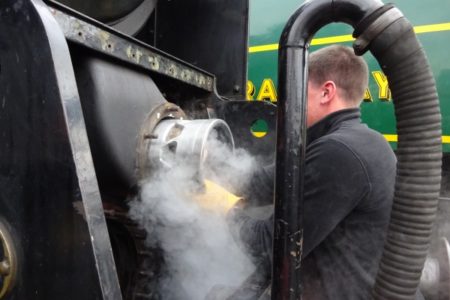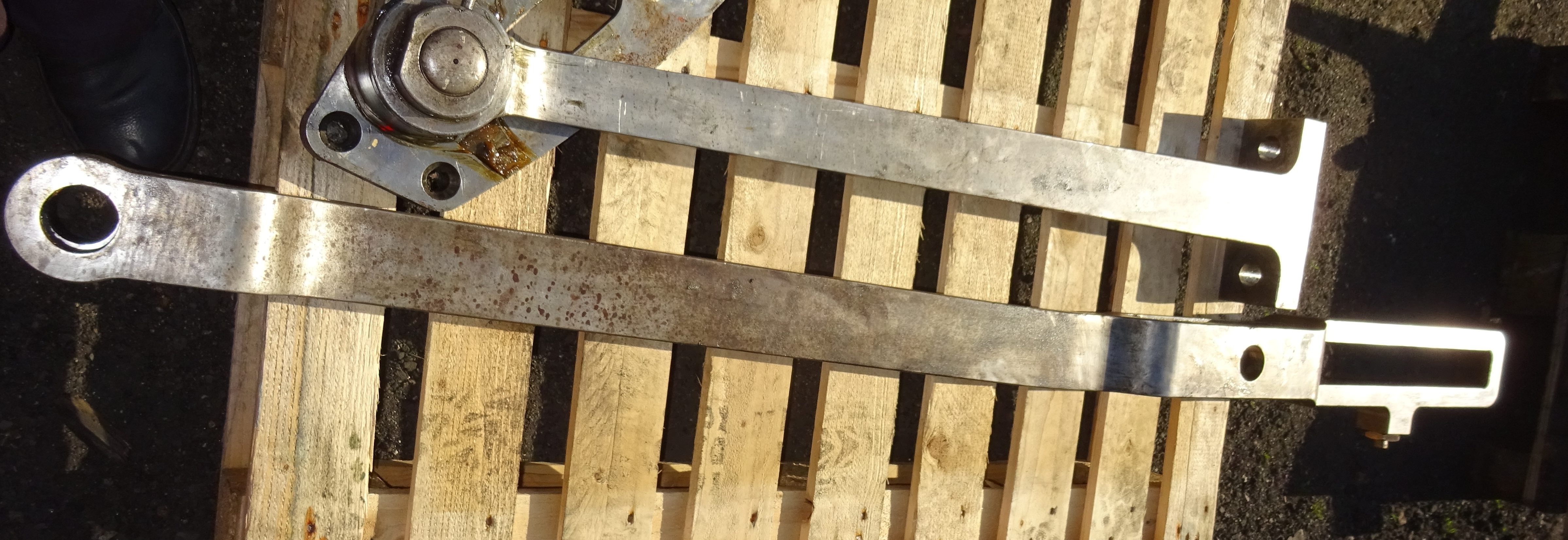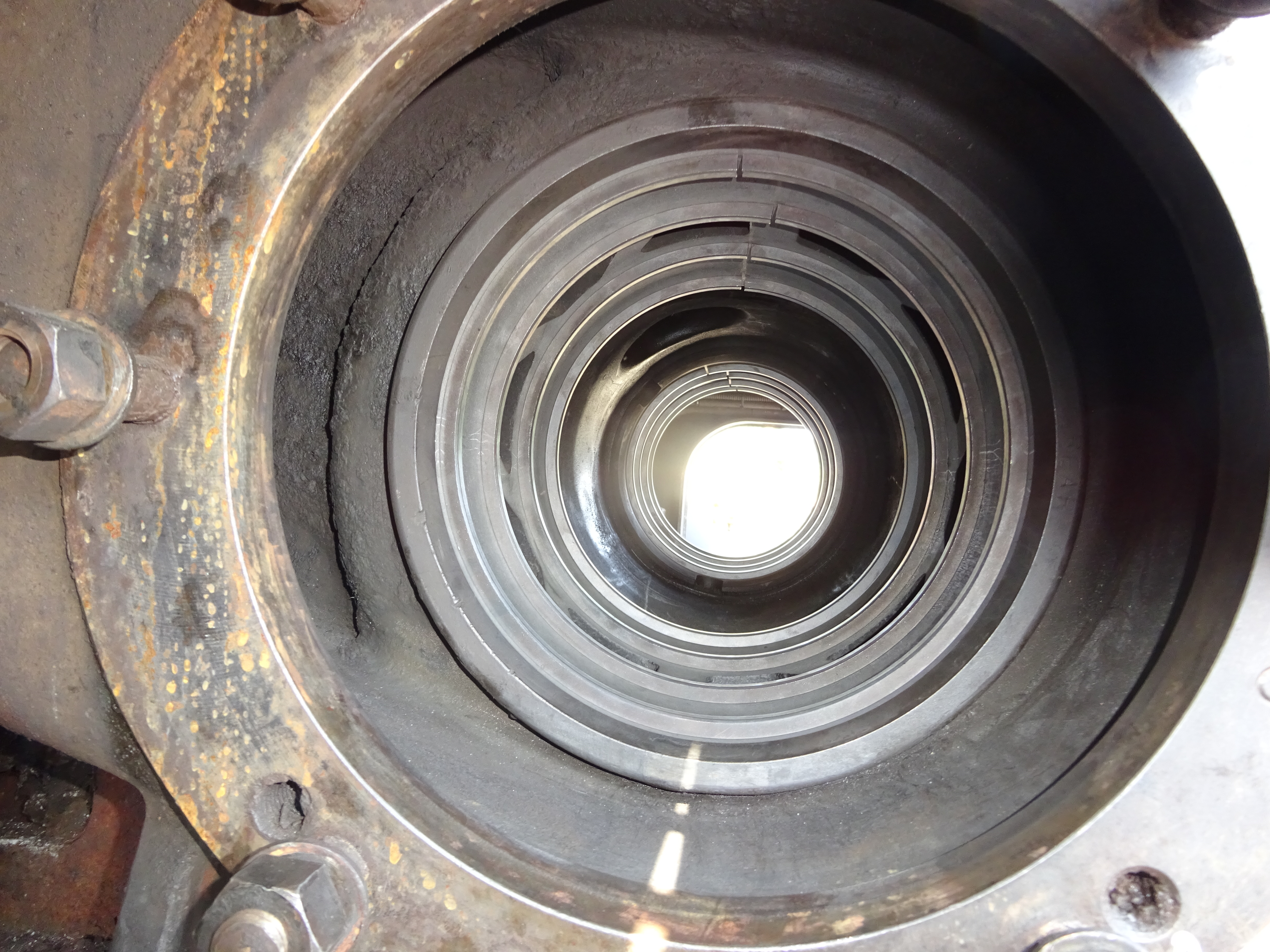Our hoped-for quick return to operations following the valve gear failure on the Ebor flyer on 14
th April did not happen for a variety of reasons. However Saturday 6
th October was a significant day in the return of
Tornado to main line operation. Following two of weeks successful running-in on the Nene Valley railway during which a total of 772 miles were covered, made up of 225 miles light engine and 547 miles loaded, one of DB Cargo’s steam examiners carried out an audit of the condition of the locomotive and the “standard” paperwork which accompanies it including test certificates for the boiler and air reservoirs, ultrasonic testing of the axles, spring weights etc. No significant defects were found, however, in addition to the essential repairs to the inside valves and valve gear, we decided to refurbish and renew parts of the outside cylinder valve gear whilst the engine was out of service.
The repair has proved to have taken rather longer to complete that we anticipated due to a number of factors, including having the locomotive based a long way from our engineering resources; and that the parts of the British mechanical engineering industry that we rely on being very busy at the moment. This resulted in long lead times to have specialist machining and welding work done.
Some firms were able to help us quickly, in particular Arthur Stephenson Engineers Ltd of Atherton who were able to forge and machine a new union link and combination lever in a short period of time for the inside valve gear, and to Durham Precision Engineering Ltd of Newton Aycliffe who rapidly CNC machined a new crosshead drop link.

The inside combination lever and union link - David Elliott
We were less lucky with the new middle cylinder valve liners, where notwithstanding the kind “loan” of two castings from LNWR Heritage at Crewe, took a long time to be finish machined which set back their reinstatement and the subsequent assembly work. Although The outside valves and valve gear were undamaged during the incident, given the problem with the middle valves, it was felt prudent to dismantle and thoroughly measure and inspect them.
In order to gain a better understanding of what had caused the original failure, all three sets of valve liners were measured in three axes by a modern Faro arm and laser tracking system which can accurately measure surfaces curved surfaces. Whilst the outside valve liners were in reasonable condition, there was some scoring so the decision was taken to lightly re-bore them to remove the marks.
The new liners were shrunk into the middle valve chest by Metalok using liquid nitrogen to cool the liners which shrinks them enough to be a clear fit in the cylinder block. As they warm up they expand and become very solid in the block. Before fitting when they are at ambient temperature, the liners are 0.008” larger than the holes the fit into in the block, so they are unlikely to move subsequently.


The new liner is inserted into the centre valve - David Elliott
All the affected parts of the inside valve gear and motion were subjected to Non Destructive Testing (NDT) to check for cracks. For items that required straightening (radius rod and slide bars) NDT was carried out afterwards as well to confirm that the straightening process had not caused any cracking. Fortunately no structural cracks were found in any of the affected components.

The best radius rod - David Elliott
One further suspected contributor to the failure was the fit of piston rings, in particular the gaps left between the ends of the rings to allow for expansion. These were found to be a bit variable, however the rings on the seized piston head were so badly damaged as to not be capable of measurement. The new rings were checked carefully that their ring gaps were correct in each liner.

The valve rings being checked in the liner - David Elliott
The broken components were subjected to metallurgical investigation by Serco Railtest at Derby. The good news is that the failure of the combination lever (which flexed until it broke) was a typical ductile failure which is what is to be expected of the relatively soft metal it is made from. The other fractures were consistent with the severe forces encountered by the now flailing combination lever and union link. The valve piston is estimated to have reached over 800°C (which is red heat) where it “picked up” in the liner. The materials of the piston head and rings were found to be to the correct specification.
A further potential contributor to the failure was lubrication. After some investigation, the key which transfers the drive from the ratchet mechanism to the lubricator cam shaft was worn resulting in some lost motion. When running fast the momentum in the pump shaft prevented it from slipping backwards during each stroke which resulted in the higher output at speed. The existing inspection regime would not detect the wear in the key as it was only visible when the pump was running with the cover off the ratchet mechanism. To overcome this the maintenance procedure has been altered to remove and specifically check the condition of the key on an annual basis. This is not felt to have been likely to have contributed directly to the failure which took place at high speed. The ratchet fitted to
Tornado since new has a single pawl. The pawl is spring loaded peg which engages in the teeth of the ratchet wheel to prevent it from turning backwards. We discovered that A4 Pacifics were fitted with a modified ratchet with three pawls acting on the wheel which reduces the risk of the lubricator stopping if a single pawl fails.
Tornado now has a three pawl ratchet.
Finally on lubrication, the oil extracted from the lubricator after the incident was found to be low in viscosity. No firm reason has been discovered for this. However we are instituting an enhanced inspection regime on new batches of oil including carrying out viscosity tests.
In summary, we have found four likely contributory factors in the failure. Each one on its own is unlikely to have cause the failure, however coming together, excessive rubbing between a ring or the valve head itself eventually resulted in localised heating which led to a thermal runaway causing the valve head to expand until it became locked in the liner. This stopped the spindle moving which placed a great load into the inside valve gear which was absorbed by flexing the combination lever until it broke.
We owe thanks to the Nene Valley Railway which has made us most welcome and have gone out of their way to accommodate moves round the yard and the use of their railway to run-in
Tornado. We are also grateful for the assistance of many other firms and individuals, including our loyal volunteers. Especially our sincere thanks goes to David Wright’s Locomotive Maintenance Services Ltd of Loughborough and his staff, particularly Andy Morgan and Andy Meredith who have spent many hours at Loughborough and Wansford manufacturing new components, fettling existing parts and fitting them to the engine.
You can read the full version of this article in TCC 51.